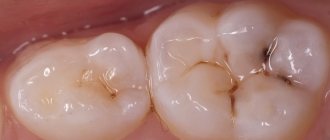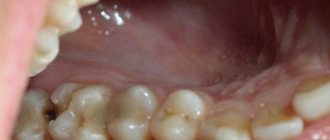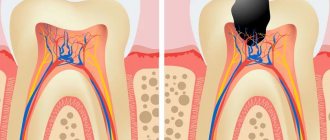- Stages of development of caries of anterior teeth
- Treatment of anterior teeth
It’s human nature to put off unpleasant things, and going to the dentist can hardly be called pleasant. But when it comes to your front teeth, you can't hesitate. Here the disease develops at lightning speed due to the fact that the enamel on the incisors is much thinner than on the molars, the load on the front teeth is no less, and they are injured much more often than others. Even constant contact with a spoon or cup can lead to microcracks in the enamel, and the tooth becomes vulnerable to bacteria and acids. A pain syndrome appears, which is more pronounced and practically cannot be relieved by analgesics.
But these are already obvious signs of the disease, and a person does not hesitate to visit a doctor. At this stage, treatment of the anterior teeth will be a serious and lengthy process, after which restoration will be required. How can you notice the onset of caries in order to stop it in the bud?
Features of treatment of anterior teeth
The four incisors in the center of the upper and lower jaws are the front teeth. They are capricious, with a thin layer of enamel and dentin, caries strikes them quickly. Therefore, at the slightest discomfort, run to the dentist!
The front teeth are a very important area not only for the patient, but also for the dentist. They are always visible; everyone will notice errors in treatment. Incisors require jewelry precision from the dentist; the enamel is thinner, so the patient experiences more pain. Don’t forget about aesthetics - an incorrectly chosen filling color or poor degree of transparency will ruin the entire treatment.
The smile area requires special care. Observation should be made for crowded front teeth that overlap each other and are too large. The lack of vitamins in the body primarily affects the incisors - vitamin deficiency does not cost anything to undermine the already thin enamel. Food that often gets stuck in the interdental spaces warns of impending caries. It is better not to delay your visit to the clinic where front teeth are treated in Moscow: at the very beginning, caries is treated without the use of a drill.
Symptoms of the disease
The symptoms of the disease in the early stages are not always obvious to the patient, especially if caries develops not on the outside, but on the inside of the tooth. But during a preventive examination in a dental office, a specialist can easily diagnose even small carious formations. This will allow you to successfully cope with the further spread of caries.
At the initial stage, caries looks like a small white spot on the tooth enamel. It is often called a "chalk spot".
This lightened area occurs due to demineralization of dental tissue. It loses nutrients, becomes more fragile and susceptible to the negative effects of external factors. Many patients do not attach importance to a slight lightening of the enamel, but it is this that serves as the first sign signaling the occurrence of caries.
With the further development of the disease, the destruction process affects a significant part of the tooth. The following symptoms occur:
- painful reactions when eating and drinking, especially hot and cold foods;
- acute toothache, which is difficult to eliminate even with strong painkillers;
- the formation of a visible carious cavity resulting from the destruction of dentin.
If carious formations are not detected and treated in a timely manner, serious complications may occur - the development of pulpitis and periodontitis.
Treatment methods – from filling to implant
The dentist will select the treatment method for the front teeth after an examination.
- Veneers or Lumineers
If the incisors are severely damaged, thin overlays can be placed - veneers or lumineers. They will hide the consequences of caries and make teeth whiter and smoother.
- Dental crowns
If only the root remains of the front tooth, intra-root inlays are made; this is the basis for the crown. Metal crowns are not suitable for front teeth; they will be too noticeable. To make an artificial tooth as similar as possible to a real one, it is better to use ceramic and zirconium crowns.
- Bridges and implants
If desired, missing front teeth can be replaced by bridges and clasp dentures. If funds allow, you can install an implant and forget about the problem for many years.
Diagnostics
Taking an anamnesis is of great importance in diagnosis. The patient is asked whether he has had complaints before. If yes, what treatment was given. The presence of general, especially endocrine diseases is clarified. Find out under what conditions he works.
Then an external examination is carried out. Pay attention to the symmetry of the face and the severity of the folds. Check the functioning of the TMJ. The height of the lower part of the face is assessed by taking special measurements.
When examining the oral cavity, pay attention to the bite, overlap of the incisors, and wear of the teeth. The contacts of the teeth are assessed when the jaws are closed.
To get an accurate picture of the condition of the crowns and bone tissue, an orthopantomogram (panoramic image) and targeted images are taken. According to indications, tomography of the TMJ is prescribed.
Treatment of caries of anterior teeth
The main method of treating caries in the front teeth is filling. When it comes to incisors, in the language of dentists this is called very beautifully - artistic restoration. It is better not to save on the cost of the filling. High-quality material will last longer and will not spoil your smile. The front teeth are always visible, so the dentist has to select the color and degree of transparency of the filling with pinpoint precision; it must match the shade of the tooth as closely as possible. Reflective composite materials do not spoil the aesthetic appearance. Over time, light fillings do not darken or wear off.
Crack on front tooth
The front teeth always get the most damage. When they “punch you in the teeth,” the blow usually falls on them. They fell unsuccessfully, worried, chewed a pencil, or, horror of horrors, chopped nuts with their incisors, and now a crack appeared on the front tooth. By the way, it can occur without mechanical damage - for example, due to temperature changes. Teeth don't really like iced coffee. You shouldn’t overuse citrus fruits or their juices either, and it’s best to dilute freshly squeezed juices with water to reduce their acidity. You should not get carried away with whitening procedures, and be more careful with abrasive pastes. Cracks are also different.
Vertical
If you are “lucky” and it is small vertical, then nothing bad will happen to this tooth, and the defect will be barely noticeable. In this case, many dentists do not recommend loading the tooth with patches. But you still need to keep an eye on the crack. If it increases, the enamel changes color, and the tooth reacts sharply to hot/cold, sweet/salty, you should consult a dentist. The enamel will need to be restored and strengthened. The crack will be treated with a special compound containing calcium and fluorine. After the course of treatment, the tooth will react normally to food and become more even and smooth.
Horizontal
But horizontal or oblique cracks in the front teeth are a cause for serious concern. They provoke the formation of caries, chips and can generally lead to tooth loss. Treatment depends on the size, depth and location of the crack, as well as the characteristics of the enamel. If there are many microcracks on the tooth and the color of the enamel has changed, the doctor may suggest installing veneers, but only after treating caries and other oral diseases. A crack left unattended will permanently split the tooth. Then there will only be one treatment option left - prosthetics.
Clinical researches
During clinical trials using a series of Asepta products, conducted in the department of periodontology of the Central Research Institute of Dentistry and Maxillofacial Surgery of Rosmedtekhnologii, Moscow, the high effectiveness of Asepta products for moderate periodontitis was proven. The use of Asepta mouth rinse turned out to be quite effective. In addition, no phenomena of mucosal irritation or brown staining of fillings were recorded. This indicates that the use of this rinse for a two-week period provides an obvious clinical effect in the absence of negative side effects.
Sources:
- Report on determining/confirming the preventive properties of commercially produced personal oral hygiene products: Asepta toothpaste used in combination with Asepta mouthwash and Asepta gum balm Head. Department of PFS Doctor of Medical Sciences Professor S.B. Ulitovsky St. Petersburg State Medical University named after Academician I.P. Pavlova. Faculty of Dentistry. Department of Preventive Dentistry.
- Clinical experience in using the Asepta series of products Fuchs Elena Ivanovna Assistant of the Department of Therapeutic and Pediatric Dentistry State Budgetary Educational Institution of Higher Professional Education Ryazan State Medical University named after Academician I.P. Pavlova of the Ministry of Health and Social Development of the Russian Federation (GBOU VPO RyazSMU Ministry of Health and Social Development of Russia)
- Clinical and laboratory assessment of the influence of domestic therapeutic and prophylactic toothpaste based on plant extracts on the condition of the oral cavity in patients with simple marginal gingivitis. Doctor of Medical Sciences, Professor Elovikova T.M.1, Candidate of Chemical Sciences, Associate Professor Ermishina E.Yu. 2, Doctor of Technical Sciences Associate Professor Belokonova N.A. 2 Department of Therapeutic Dentistry USMU1, Department of General Chemistry USMU2
Loose front teeth
Loose front teeth are a wake-up call. Often this trouble happens with the front teeth. The main cause of looseness is gum disease: periodontal disease, stomatitis, gingivitis. You should not run them, otherwise you may end up without teeth at all.
The doctor will select the treatment for loose teeth individually. If the swaying is accompanied by pain, the teeth deviate significantly to the sides, the dentist applies special splints, removable or non-removable, to the incisors. Splinting strengthens mobile teeth, prevents their loss, and allows periodontal tissues to recover. In severe cases, surgical treatment cannot be avoided. During surgery, the surgeon removes bone tissue or restores it using metal shunts.
Cysts in the tooth canal and granuloma have a bad effect on the roots, and the teeth begin to become loose. These tumors need to be removed. If the tooth begins to loosen after a blow or injury, it is better to go for an x-ray.
Splinting with metal wire
This retention splint is made of medical steel - twisted or intertwined thin wires. The more there are, the more resistant the wire is to deformation and stretching.
It is usually glued to the inner surface directly onto the enamel. This type of splinting is often used after correcting the bite in order to stabilize the results of treatment, or as a temporary splint in the treatment of periodontitis - when the situation returns to normal, the splint can be removed without harm to the enamel. Among the disadvantages is, again, the gray color, as is the case with the use of aramid thread. That is, if there are gaps in the row, it is better not to use it.
If your front tooth hurts after treatment
Patients often complain that their front teeth hurt after treatment. The dentist cleaned the canals, so this is normal. The discomfort should go away within a few hours. But if the treatment is done poorly, the tooth may hurt for a long time - and this is already a deviation from the norm. Most likely, the doctor made a mistake during treatment and the entire filling process will have to be repeated. The cause of pain can be a burn of the pulp, damage to the enamel, an allergy to medications, or acid contact with dentin.
How much does front tooth treatment cost?
The cost of treatment depends on the method and materials used. When it comes to the smile area, it is better not to skimp. In this case, prudent patients often have to remember the stingy man who pays twice. Choosing cheap materials often leads to aesthetic flaws, disappointment and repeated treatments.
As a rule, prices for treatment of front teeth in Moscow start from 2,000 rubles. For example, the cost of caries treatment without drilling ranges from 2,000 to 5,500 rubles. A light seal costs from 1,500 to 10,000 rubles. The price tag for splinting loose front teeth starts from 2,800 to 7,000 rubles. Removing a cyst will cost 7,000 - 37,000 rubles, granulomas - from 5,000 to 40,000. A dental inlay will cost from 5,200 to 20,000 rubles. Prices for veneers start from 5,000 rubles, lumineers - from 40,000. The range of prices for zirconium crowns is from 13,500 to 40,000, ceramic - from 17,000 to 57,000. Clasp prosthesis will cost from 29,000 to 73,000, dental implantation - from 30,000 to 120,000 and more.
Periodontitis
Another complex disease that can be caused by advanced caries is periodontitis. It is accompanied by damage to the root shell of the tooth and adjacent tissues. The main symptoms include pain when biting. It is treated with the same methods as pulpitis. But in terms of time, this is a more protracted process, especially if you went to the doctor in the acute stage. In this case, the doctor needs to eliminate the infection both inside and outside the tooth. Let us remember that tooth extraction is a last resort. Increasingly, dentists are performing tooth-preserving operations, which include:
- Resection of the upper part of the root;
- Root resection;
- Hemisection.
In the event that extraction could not be avoided, implantation and prosthetics will help restore the dentition.











